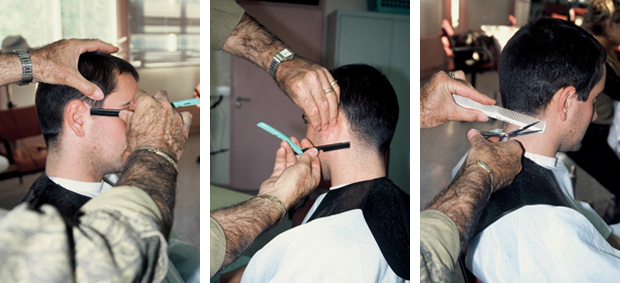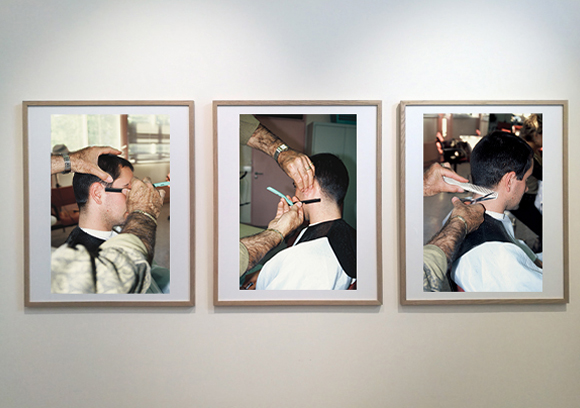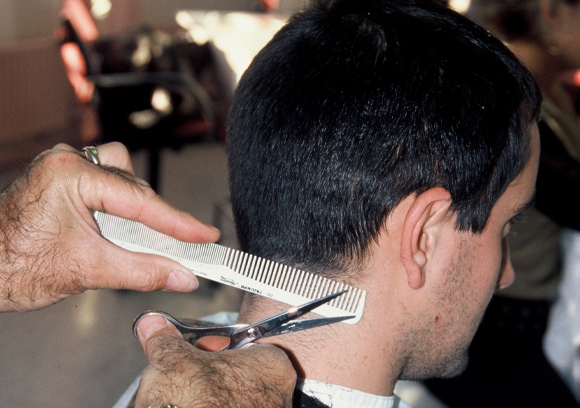| |
|
|
04.
| Square Cut |
| |


2000, triptych.
Exhibition view from Ovalprojet, CAC Le Chaplin, 2002, Mantes-la-Jolie.
Courtesy of the artist.
Ed. of 5 + 2 A.P.
'' In « Square Cut », the hair salon ritual is associated with the religious ritual of the believer preparing to be in communion with God, and the hairstyle of the customer, the square cut,
is representative of a formal rigor whose equivalents can only be found in architecture or in post-minimalistic hairstyling currents. ''
Studio Fatmi, January 2018

Square Cut
Exhibition view from Ovalprojet, CAC Le Chaplin, 2002, Mantes-la-Jolie.
Courtesy of the artist.

Square Cut
Exhibition view from Ovalprojet, CAC Le Chaplin, 2002, Mantes-la-Jolie.
Courtesy of the artist.
|
|
|
|
|
|
« Coupe carrée » est un work in progress photographique initié en 2000 dont la genèse s'organise autour d'une figure géométrique, le carré. Le carré ou le cube sont des formes récurrentes dans les œuvres de mounir fatmi, où elles sont notamment utilisées dans diverses représentations de la Kaaba, lieu de culte musulman, et entrent dans diverses expérimentations géométriques. Le carré ne symbolise pas seulement les dogmes de la religion, il est également une figure qui rend compte de son fonctionnement et qui permet d'explorer le rapport du croyant à la religion à travers les rituels et les objets de culte. La religion et les croyances sont du thème fréquemment traité dans les œuvres de mounir fatmi, dont l’étude, inspiré des différents courants artistiques est menée à travers différents médias, peintures, sculptures et installations. Chacune de ces œuvres s'attache à observer et reproduire des fonctionnements afin d'en faire prendre conscience au spectateur. Le carré est ainsi envisagé comme une structure qui impose une attitude physique et spirituelle au croyant. Il est également une forme à l'esthétique pleine de séductions, de mystères et d'interdits, qui en impose au spectateur en fixant strictement ses limites à angles droits.
La série photographique « Coupe carrée » de 2008 est ancrée dans le décor d'un salon de coiffure. Elle reproduit une scène classique qui a lieu dans tous les salons de coiffure du monde, celle du client assis sur un siège et passant sous les ciseaux experts du coiffeur. Elle livre ainsi au regard du spectateur différentes perspectives du crâne d'un client venu se faire couper les cheveux et revêtu du tablier de coiffure noir à col blanc rituel. Avec une ironie discrète, la composition donne à voir un individu passivement soumis aux manipulations d'une autorité tierce et dont l'identité véritable demeure un mystère. La notion de danger n'est cependant pas exclue dans cette scène, mentionnée discrètement avec l'apparition sur les images du rasoir et de la paire de ciseaux, outils indispensables du coiffeur, et qui rappellent que la vie du client est provisoirement entre les mains des autorités compétentes.
La violence des processus éducatifs et religieux est un thème traité dans de nombreuses œuvres de mounir fatmi, qui se retrouve notamment dans ses sculptures réalisées à l'aide de scies circulaires calligraphiées ou de ses vidéos et photographies inspiré du film « L'Enfant sauvage » de Truffaut, où il est justement question de coiffure et de ciseaux dans une de ses scènes. Dans « Coupe carrée », le rituel du coiffeur se voit associé au rituel religieux de préparation du croyant qui s'apprête à communier avec Dieu, et le style capillaire du « coiffé », la coupe carrée, fait preuve d'une rigueur formelle qui n'a probablement d'égale qu'en architecture ou dans les courants post-minimalistes de l'art capillaire.
Studio Fatmi, Janvier 2018. |
|
« Square Cut » is a photographic work in progress initiated in 2000 and structured around a single geometric figure, the square. The square and the cube are recurrent shapes in mounir fatmi’s work, in which they are used for various representations of the Kaaba, an Islamic place of worship, and are part of a diversity of geometric experimentations. The square doesn’t only represent religious dogma; it’s also a figure that summarizes its functioning and allows for the exploration of the relation of the believer to religion through rituals and objects of worship. Religion and faith are a theme frequently addressed in mounir fatmi’s work; their study, inspired by various artistic movements, is conducted through a variety of media: paintings, sculptures and installations. Each one of these works of art attempts to observe and reproduce ways of functioning in order to make viewers aware of them. Thus, the square is approached as a structure that forces a specific physical and spiritual attitude on the part of the believer. It is also a shape whose esthetic is rife with seductions, mysteries and prohibitions, and which imposes itself on the viewer with the rigidity of its right angles.
The 2008 photographic series « Square Cut » is set in a hair salon. It reproduces a classic scene that happens in every hair salon in the world: the customer in a seat while the hairdresser expertly cuts the hair. It thus offers to the viewer’s gaze various perspectives on customers’ heads, as they wear the traditional black hair salon blouse with its white collar. With a touch of irony, the composition shows an individual passively submitting to the manipulations of a figure of authority whose true identity remains mysterious. But the notion of danger isn’t absent from this scene, as it is discreetly alluded to through the presence in the images of the razor and the pair of scissors, a hairdresser’s essential tools, reminding us that the customer’s hands is temporarily between the hands of a competent authority.
The violence of educational and religious processes is a theme addressed in many of mounir fatmi’s works. It can be found in particular in his sculptures created with calligraphed circular saw blades and his videos and photographs inspired by François Truffaut’s movie « The Whild Child », a scene of which is precisely about scissors and cutting hair. In « Square Cut », the hair salon ritual is associated with the religious ritual of the believer preparing to be in communion with God, and the hairstyle of the customer, the square cut, is representative of a formal rigor whose equivalents can only be found in architecture or in post-minimalistic hairstyling currents.
Studio Fatmi, January 2018. |
|
|
|